Your Quick Start Guide to Cross-Border Ecommerce in China, India & The Middle East

Centuries before GPS and various forms of travel technology, navigators relied on stars to point them in the right direction –– using them as a guidance tool while embarking into territories and corners of the globe not yet reached.
While we have come light years from relying on stars for determining direction, we still rely heavily on tools and technology to guide us.
As merchants venture off into new markets, the very first step is almost always around discovery:
Where do we go?
How do we get there?
What to do when I get there?
Wouldn’t it be easy if there was already a “Quick Start Guide” on doing business globally?
That’s what we have set out to do.
Below you will find a country-by-country, quick-start guide to entering each respective market.
From marketplaces to social commerce platforms, everything that you need to know as a merchant is right here, right now.
The International Expansion Playbook
What if you are ready to invest in international expansion and localization to own a brand new market long before your competitors?
That’s what this guide will teach you to do.
How to Sell Online in China
Online retail sales in China reached 5.16 trillion yuan ($752 billion) in 2016, representing 26.2% growth from 2015—more than double the growth rate of overall retail sales, according to China’s National Bureau of Statistics, the agency charged with tracking economic data.
Want a slice of that pie? Of course you do. Here’s how.
TMall
Selling in China to-date for most U.S. and Western European merchants has been via TMall.
Unlike most marketplaces, TMall offers what is known as a Storefront marketplace, where merchants can have a fully branded flagship store within their marketplace.
However, to do so, you will have to successfully prove that you have an in-country agent or business.
This requires the following documentation:
Copy of a business license from mainland China
Copy of corporate tax registration certificate from mainland China
Copy of organization code certificate
Copy of bank account permits
Copy of legal representative ID card
Copy of TMall flagship store owner’s ID card
Trademark registration from the state trademark association
Alipay corporate account authorization
Completed product list
Providing this documentation may be difficult if you do not have an in-country partner or if you are simply just getting started with selling globally.
Of course, there is a second option…
TMall Global
The big advantage of TMall Global is that organizations do not have to have a legal entity in China, in contrast to other ecommerce platforms (including the standard TMall).
In addition to shipping orders from the country of origin, the brands can also ship from storage facilities in free trade areas in Shanghai, Ningbo, Hangzhou, Zhengzhou and Guangzhou.
This reduces delivery times and the logistical costs per shipment –– and is more relatable to many brands, since this model is similar to Amazon’s FBA.
Plus, the applicable tax rate for purchases from these zones is 10% instead of the regular import tariffs of approximately 30-40%.
The types of stores you can open on TMall
Lastly, in China, specifically on TMall, it is important to understand the differences in the types of stores that you can open.
Currently, there are three types of stores that merchants can apply for:
Flagship Store
Authorized Store
Specialty Store
Flagship Store
Flagship stores can only be opened if the merchant is the brand owner (trademark owner) or possesses authorization from the brand owners of the products.
Flagship stores can be authorized and launched under the following circumstances:
Store sells and acts on the behalf of a single brand that is owned by the merchant opening the store
Store sells and acts on the behalf of multiple brands that are all owned by the merchant opening the store
Store sells and acts on the behalf of a multi-brand marketplace (service-class trademark) owned by the merchant opening the store

Nike on TMall example
Authorized Store
Authorized stores are stores run by merchants which hold a license from a brand to do business on their behalf in a specific region, in this case, China.
Authorized Stores can be opened under the following circumstances:
Store is authorized to sell products from one brand
Store is authorized to sell products from multiple brands, but all brands belong to the same entity
To give a quick example (though not on TMall), Power Support is a U.S. store selling goods from Japan. The owner of the store is authorized by the brand owners, and is the only branded seller in the U.S. He reports his numbers back to the original owners, but has leeway to grow the business as he sees fit.
That would classify as an authorized store on TMall.
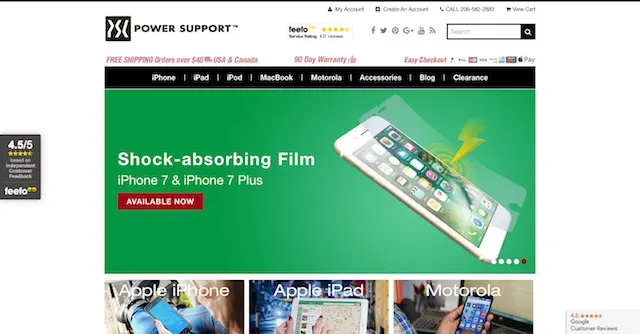
Specialty Store
Specialty stores are for merchants that sell products in multiple categories; however, are not the brand owner. Specialty stores can be opened under the following circumstances:
Store sells products from two or more brands that the merchant does not own
Store sells products from a brand (trademark) owned by the merchant and sells products from a brand not owned by the merchant
Store sells products from two or more brands that the merchant owns
Find the Fit for You
Your biggest takeaway here is that you have options on TMall.
Regardless, however, of whether you are on mainland China or looking to stay abroad as you expand, your storefront must be available in Chinese, as Chinese buyers must have access to Chinese customer service and the product must be returnable to an address in China.
Additionally, merchants must provide certificates of authenticity of the brand to prevent the sales of shanzhai (fake) products.
While marketplaces have dominated in China to-date, the rise of mobile commerce has accelerated with the adoption and penetration of social commerce platforms like WeChat.
WeChat gives shoppers and users a quick, easy in-app checkout via WeChat Pay. Like TMall, brands can create Official Accounts that enable them to have Flagship stores built within WeChat.
Also like TMall, to register an official account on WeChat, merchants will need the following documentation:
Chinese ID
Chinese mobile phone number
Chinese business license
Chinese organization code
Tencent, the managing group of WeChat, does not allow non-Chinese merchants to apply for official accounts for free.
Instead, the application costs for non-Chinese merchants looking to start an official store on WeChat are $1,300 (USD) and can take up to 4 months to process.
Understanding Store Types; Service versus Subscription
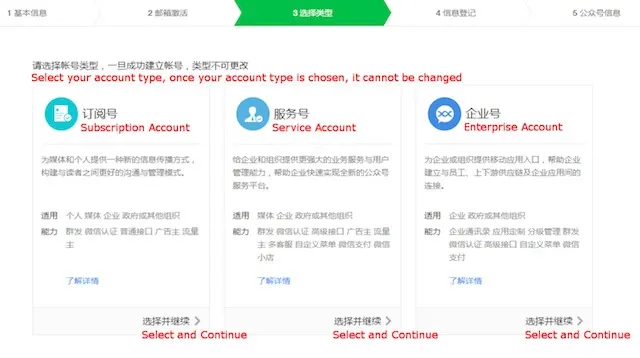
When registering a WeChat Official Store, merchants will be given the choice of creating a Subscription, Service, and/or Enterprise account. The two that we will focus on for initially penetrating China via WeChat will be:
Service Accounts
Subscription Accounts
Depending on what the goals of your brand are, awareness versus sell-through, both of these models provide benefits that can fit your needs.
Service Accounts
Arguably the best account for ecommerce lead initiatives, service accounts allow merchants to accept in-app purchases via WeChat Pay and other forms of preferred payment. This removes barriers to entry when considering payment types in China.
Additionally, Service Accounts have the following functionality that Subscription Accounts do not:
Connected Objects – iBeacons deliver content via WeChat native functionalities
Ecommerce – WeChat Pay allows your shoppers to purchase in-app
Geo-Location – Enables you to send push notifications based on location, great for larger merchants that practice O2O (offline-to-online)
QR Codes – Generate easy-to-use QR codes that can better connect digital and physical
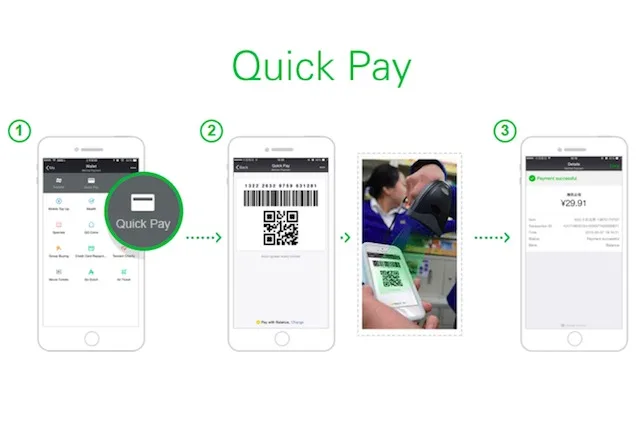
Subscription Accounts
The biggest benefit of a Subscription Account is the associated publisher tools. Unlike Service Accounts, Subscription Accounts can publish 1 message per day; whereas Services Account are only given 4 per month.
However, the downside of Subscription Accounts is that you cannot leverage ecommerce functionality.
Key Notes
It is important to remember that not all WeChat accounts and users are the same. For example:
Non-Chinese WeChat users have access to Both Chinese and Non-Chinese official accounts.
Chinese WeChat users only have access Chinese registered accounts.
Both should be taken into consideration when determining whether to leverage an in-country partner to verify a Chinese business standing or do it as a recognized cross-border merchant operating outside Mainland China.
Cross-Border Ecommerce in India
According to an ASSOCHAM-Forrester study, India’s ecommerce revenue is expected to jump from $26 billion in 2016 to $103 billion in 2020.
While in terms of the base, India may be lower than China and other giants like Japan, the Indian rate of growth is way ahead of the others.
Against India’s annual growth rate of 51%, China’s ecommerce market is growing at 18%, Japan at 11% and South Korea at 10%.
Here’s how to get on that market right now.
Flipkart
While Amazon begins to tap into India, Flipkart remains the market leader in terms of marketplace opportunity for selling across borders.
Currently, Flipkart has more than 7.5M core registered customers and ships more than 800,000 packages, per month, to more than 1,000 cities.
Like marketplaces and social commerce platforms in China, Flipkart mandates that you show proof of having a business established in-country.
Again, this not a complete roadblock; however, it does require an in-country partner that can provide residency and show documentation.
When signing up for Flipkart Seller Portal access, you will need to provide the following documentation:
PAN Card (Personal PAN for business type “Proprietorship” and Personal + Business PAN for business type as “Company”)
VAT/TIN Number (not mandatory for books)
Bank account and supporting KYC documents (Address Proof, and Cancelled check)
Minimum of 10 unique products to sell
The Benefits of Selling through Flipkart
If merchants decide to sell on Flipkart, there are a tremendous amount of benefits that alleviate and better mitigate risk when selling in India.
Shipping: Flipkart handles the shipping of your products. All merchants need to do is pack the product and keep it ready for dispatch. Flipkart’s logistics partners will pick up the product from you and deliver it to the customer.
Seller Protection: Flipkart has set up a Seller Protection Fund (SPF) to protect merchants against fraud. Merchants can request for SPF claim through the seller dashboard. When the buyer or logistics partner is at fault, you will receive due compensation.
Easy Payouts: All merchant payments are made through NEFT transactions (online banking). The payment is made directly to the merchant’s bank account within 7-15 business days from the date-of-order dispatch. It’s 7 business days for Gold Sellers, 12 business days for Silver Sellers and 15 business days for Bronze sellers.

Snapdeal
While Flipkart has become the more notable Indian marketplace, Snapdeal is India’s second leading marketplace and has quite the market share.
Today, Snapdeal has around 300,000 sellers and delivers in more than 6,000 cities and towns in India.
In March 2016, its gross merchandise value stood at around $4 billion.
Like Flipkart, Snapdeal mandates that merchants wanting to sell into India via their marketplace have an in-country business entity.
For merchants wanting to sign-up, they will need the following to access their Seller Portal:
PAN Card
VAT/CST number
Bank Account number
The Benefits of Selling on Snapdeal
Customer Shopping Experience: Unlike Flipkart and Amazon, Snapdeal goes above and beyond in creating a very easy-to-shop user interface and experience online. From category landing pages to their product detail pages, the marketplace does a great job of communicating to consumers their merchant’s product value in a more B2C way than normal marketplaces.
Cross Border Merchant Friendly: Unlike Flipkart, Snapdeal allows cross-border merchants to ship from their domestic distribution centers, not requiring them to make the in-country inventory investment. This is a favorable advantage when penetrating the market by keeping initial investments to a minimum.

4 Steps to Conquer Ecommerce Penetration in India
While Indian marketplaces require merchants to have an in-country partner to act as the merchant of record, what happens once merchants have successfully “landed” in-country?
For many, the road and path of least resistance is still unknown, as India still represents a market with few to no foreign experts for merchants to lean on.
That’s why we reached out to Tony Navin, SVP, Partnerships and Strategic Initiatives at Snapdeal.
He grew Snapdeal’s electronics and general merchandise units up to $2 billion since 2012, constituting 80% of the marketplace’s business.
And he did all of this while spearheading the marketplace’s monetization revenue stream and building out its advertising platform.
A former start-up entrepreneur himself, Navin fully understands the Indian market, top to bottom.
Here are the 4 steps Navin recommends for those that have started or are evaluating launching an Indian ecommerce channel:
Create brand recall with in-country awareness and SEM
Build strong relationships with marketplace stakeholders
Save on supply chain by leading with online
Follow the right trends
Building in-country awareness
Just like doing business domestically, merchants have to build awareness for both their brand and products. Cross-border commerce is no different.
In India, shoppers follow the same discovery behaviors as those in the U.S., AU or Canada, using search across multiple online channels. To be successful, merchants have to look at SEM as a necessary investment when entering the Indian market.
“Merchants have to consistently evaluate the way they engage in marketplaces,” says Navin. “Brands need to create recall, so when shoppers search for specific goods, your products are at the top of search results and category landing pages.”
Advertising on Snapdeal
Currently, Snapdeal allows its merchants to leverage its robust advertising platform in two forms:
Brand Ads
Product Ads
Depending on the goal of your campaigns, the marketplace’s advertising features allow you to connect and build relationships with consumers authentically, yet strategically.
Below are areas within the marketplace that merchants are allowed to buy ad space:
Homepage
Product List Page
Category Pages
Search List Page
Product Details Page
Order Confirmation Page
Marketplace representatives are just as important as consumers
While building confidence and trust with local customers is objective #1, do not forget that marketplace associates and representatives are just as important.
The reality of India is that 1000s of merchants are selling online –– what makes your product different? What makes you stand out? How can these associates help to increase your visibility?
These associates are like influencers in the U.S. market. Build your relationships with them early on. They need to be aware of your presence, so be proactive!
Navin says continuous engagement is necessary when building relationships with marketplace associates. “Do it daily and consistently,” he says.
Use online to generate buzz and cut costs
In 2000, cellular giant Motorola exited the Indian market amid continued decline of market share and sales. However, in 2012, the brand returned with force, recapturing both market share and sales in a digitally driven re-launch.
What was the key to their success?
Navin calls it, “investing smart.” Simply put, merchants that want to enter or re-enter the Indian market need to make investments.
But where do you invest first?
Navin suggest a hybrid model, taking an online-first approach to generate buzz, but also cutting supply chain costs by selling digital rather than physical to start.
Moreover, while many marketplaces require cross border merchants to have in-country stock, Snapdeal is seller friendly, allowing merchants to ship from their domestic distribution center, enabling them to successfully penetrate the market with minimal inventory/shipping investments.
Don’t fit a square peg into a round hole
When determining whether or not India is a viable market to penetrate, consider current consumer demand within your vertical.
Currently, India’s top categories are:
Electronics
Appliances
Entertainment Devices
Smart Phones
Apparel & Footwear
When it is all said and done, India represents massive opportunity for the right merchants. For merchants that fit the mold, finding a local partner is probably the best course of action.
Lastly, as you merchandise your catalog for in-market distribution, be considerate of “hygiene factors,” says Navin while describing India’s socioeconomic factors, adding, “India is religiously sensitive, so be mindful of how your products impact local culture.”
How to Sell in the Middle East
The Middle East is on the verge of a massive digital disruption with significant untapped ecommerce potential, according to a 2016 Digital Middle East report by McKinsey & Company.
The key driver of this is the Muslim market, which is expected to grow to $484 billion by 2019, according to the 2014-15 Thomson Reuters State of the Global Islamic Economy Report.
For western merchants, the growing category in-market remains luxury and premium-priced apparel, beauty and footwear.
If you sell in one of those categories, here’s how to get launched in the Middle East.
Namshi
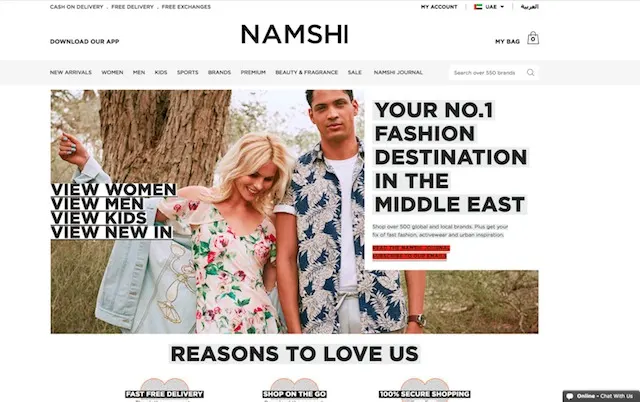
Namshi is part of the Global Fashion Ecommerce Group created by Rocket Internet. It is a Dubai-based online fashion retailer with more than 40,000 exclusive in-house collections and brands such as Adidas, Nike, Diesel, Topshop, Lacoste and Vans.
It has seen significant growth over the past two years.
The platform is experiencing massive market adoption and penetration for both cross-border commerce and mobile commerce.
Over 80% of Namshi shoppers use mobile or tablet devices to access Namshi. Mobile traffic currently tops 175 million pageviews monthly, with 18 million pageviews on desktop.
Selling on Namshi is by application only.
The Modist
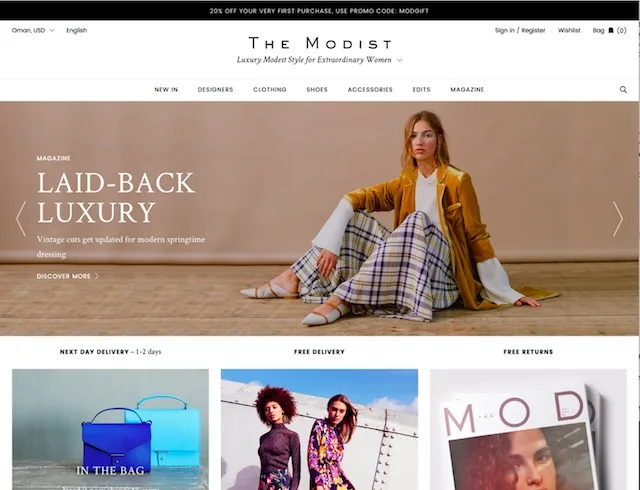
The newest challenger is the Middle Eastern market that just went live in 2017. It has an aesthetically pleasing shopping experience and is cutting into the growing fashion market.
The Modist, a Dubai-based ecommerce site, offers 75 contemporary designer brands to women whose religious, cultural or personal tastes lean toward a modest style aesthetic.
It is a great way of merchandising in-country that simultaneously caters to cultural and socio-economic expectations and norms.
Amazon’s Influence in the Middle Eastern Market
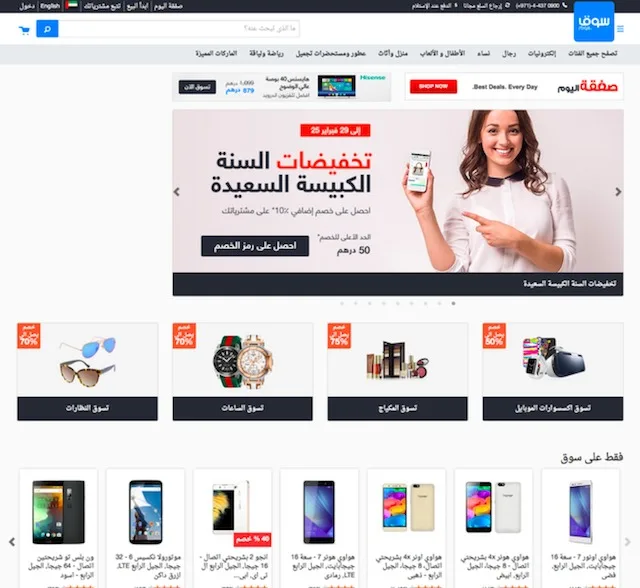
Making headlines in 2017 was Amazon’s acquisition of regional leader Souq.com.
Souq, the largest ecommerce company in the Middle East, was founded in 2005 on an eBay-like online auction model, but it subsequently evolved into more of an Amazon-style set-price retailer.
Souq.com currently has more than 8.4 million products for sale and has over 45 million visits per month.
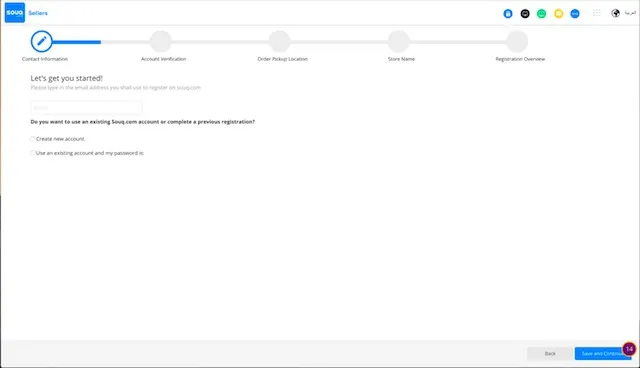
Selling on Souq
Like Asia Pacific marketplaces, Souq.com requires that you have an in-country partner to show support documents that allow you to sell in each specific country.
Those requirements include:
Local Shipping location: Souq will use the details of this location to pick up your orders and deliver them to the customers. Please note that you will be required to verify the mobile phone number used to contact this location.
Trade license and ID: When selling in specific categories, Souq requires the trade license and ID verification for legal purposes; this will insure that you’re allowed to sell them in a specific country.
Final Word
For brands selling in the luxury market, the Middle East has multiple options for you to expand your business.
For those looking to sell in India, electronics and apparel & footwear do best. In China, just about anything goes, though having an in-country presence is ideal.
Overall, which region you choose to launch into is based on your brand, what you sell and where you can afford to get your feet on the ground to understand the market and test the water.
The International Expansion Playbook
What if you are ready to invest in international expansion and localization to own a brand new market long before your competitors?
That’s what this guide will teach you to do.

Sergio Villasenor is the Founder and CEO of Elliot, a software that simplifies global commerce. In the last decade, he’s guided some of the world's leading retail brands in powering their omnichannel strategies. He pioneered an agile, omnipresent approach and methodology that provides brands solutions with measurable business impact. Some of those brands include: Anastasia Beverly Hills, Buscemi, J Brand Jeans, John Varvatos, Juicy Couture, Rag & Bone, the Frye Company and more than 30 others.


